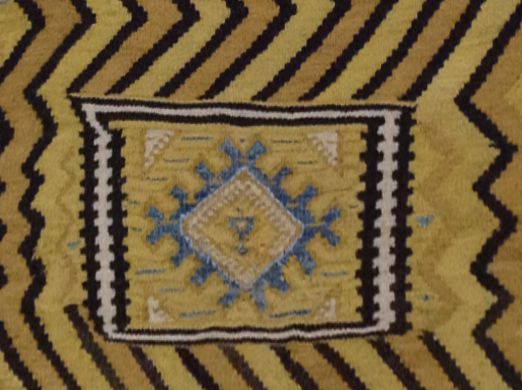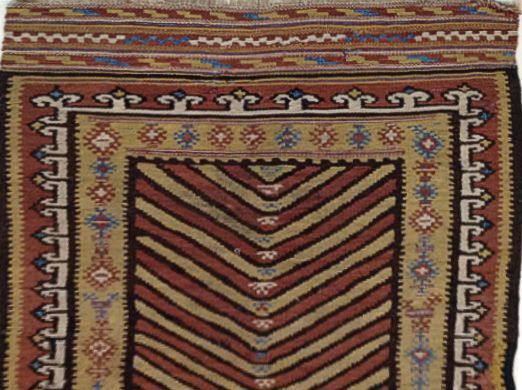M.U.R.A.T.S.
The Museum of Sardinian textiles
Samugheo has always been one of the most important villages in Sardinia for the textile art. Its geographical isolation was a key element in the conservation and preservation of the cultural tradition and craftsmanship, one of the most prolific and original of the island. In the lovely village of Mandrolisai the traditional weaving is very flourishing and full of many fascinating aspects. The creation in 2002 of the Murats (Museo Unico Regionale Artigianato Tessile Sardo: Unique Regional Museum Sardinian Textiles Craft), was the direct result of this vocation, aimed at preservation of the memory not only of textile Samugheo but of the whole Sardinia.
The Museum exhibits an extensive collection of artifacts from all over the Island. Many of them are of great value and were recovered in different areas of Sardinia and exposed in the permanent section of the museum that is located on the first floor.
We reached the Museum Director, Dr. Baingio Cuccu, which tells us about the most ancient and precious artifacts in the structure and all the initiatives that are being carried out.

The museum, created in 1998, was inaugurated in 2002; twelve years later we would know to say what were the results achieved and if the objective to preserve, protect and promote the culture of textile art in Sardinia, has paid off?
With activities and exhibitions of the Museum MURATS we strive to preserve and bring the textile sector as something that goes beyond the traditional crafts; indeed, the museum, in addition to owning one of the largest and most complete collections of textiles in Sardinia, offers exposure and a cross-section, in continuous dialogue with the territory of one of the industry which has recorded the history of the society and economy of Sardinia highlighting it as something that goes beyond the production of simple objects of daily use.
The works in the collection come from every part of the island and are representative of different types of work, starting from saddlebags to blankets, from tapinu 'e pane (bread carpets) to chest covers to the very rare Tapinu e' mortu (dead carpet) and the Affaciadas.
In addition there are a large number of other products such as tablecloths, several ancient parts of the traditional Samugheo dress, plus a nourished group of pieces of daily clothing from other centers of the Island. Artefacts covering a period of time between the end of 1700 to the second half of the twentieth century.
This large body of work makes the MURATS a place where this precious "documentation" can be preserved, studied and exhibited to ensure the next generations a wide "witness" what the textile tradition of Sardinia is.
One of the most striking aspects of the MURATS, in addition to the value of various items, is the continuous succession of cultural events which sometimes go beyond the purely textile point of view. It explains how and why to do these initiatives and how to do the public response?
The last three years the Museum, while maintaining its nature and mission of the Textile Museum, opened to other forms of art, dealing with some of the most interesting interpreters of Sardinian artistic world through a series of exhibitions that put them in dialogue with the museum, its collection, but also with what is the analysis of significant events of our territory, as moments or occasions that have a particular influence on the community.
The MURATS, because of its nature, is a museum that has a strong connection with the territory and it cannot be separated from confronting what happens around. The ability to open up to new types of languages brings hit, then, as a study place, analysis and laboratory contemporary textile and beyond.
These openings have allowed the museum to become more and more an open, dynamic and able to attract the interest of a greater number of fans and visitors. Without affecting what makes it unique: the presence of an important textile collection always visible through an exhibition of its best pieces that are made to rotate in different modes of installation.

Last year was held a very interesting contest where different artisans of Samugheo had to create a handmade textile on the basis of many projects designed by Italian and foreign artists, trying to keep within the design elements of the textile tradition of Sardinia. What was the outcome of this initiative?
Annodarte is one of the parallel events of the temporary programming of the Museum and has been designed and strongly supported by the Municipality of Samugheo. These types of activities, as well as take the form of temporary exhibitions, give life to workshops, meetings as well as contests to stimulate creative experts to rediscover and revitalize of the textile industry. Precisely in this mode has developed the ideas contest Annodarte.
The first part took place in 2013 when the contest was launched as a project of enhancement of local crafts in order to propose a raise handicraft textile of Samugheo through new products. All we are aiming to create a partnership between local artisans and designers. The goal is to develop a new line of rugs, in which the traditional technique dating innovative design and research into forms and materials.
The contest involved many professionals including designers and architects, with forty-seven projects from all over Europe, the top five were honored and the top fifteen were selected with the intention of creating a new collection of rugs made by the craftsmen of Samugheo. The next step was taken this year at the 47th edition of Tessingiu_Exposition of Sardinian Handycrafts, with exposure at the MURATS of the first five prototypes of the carpets plus fifteen projects that will create the new collection.
What should the Sardinian textile sector to carve out an important place in the local economy while keeping intact its identity?
The textile sector should be continually renewed, as it has happened before. This innovation should be made taking into account the uniqueness that distinguishes the typical processing traditionally made in Sardinia. Firstly, the fact that we have experienced people with ability to create textiles through unique techniques of their kind, we have the wisdom and tradition for the production of manufactured entirely manual (which makes them qualitatively and aesthetically exclusive) where each piece can be considered an unicum.
These excellent bases must then combine the ability to be able to renew and also to be close to what the market is demanding, because you can accomplish a dual type of production, the traditional, which already has a market demand, and sold to other markets that with globalization have opened and have different needs. In summary, we must try to bring the textile Sardinian product beyond regional and Italian borders, maintaining its uniqueness and identity and at the same time be flexible.
Among the fabrics of higher quality and rarity and extremely interesting there are five tapinus 'e mortu (dead carpet) that certainly worth a mention. These are carpets that had also funerary use; probably they were, in fact, used to lay the corpse during the wake. They are characterized by a complex symbolism and have an origin in the Middle East as they are incredibly similar to Kilim, (hairless carpet product in Anatolia).
In Sardinia, the origin of these carpets is mainly concentrated in Orgosolo. The most striking thing are the lines in a zigzag, very similar to those of the Kilim carpet representing ancestral symbols of lightning, thunder and flow of water. Are very interesting also the strong colors, especially the yellow approached to the black.
In Sardinia we have, actually, only twelve specimens of tapinus' and mortu. MURATS holds five, all in excellent condition.
The importance of this museum is undoubtedly because succeeds, among other things, to combine a wise look to the past, never forgetting the tradition, preserving the rich textile heritage of Sardinia, but also looking to the future, innovation, renewal, new opportunities. A perfect combination that day by day is getting way.
MURATS
Unique Regional Museum Sardinian Textiles Craft
Via Bologna
09086 Samugheo (OR)
Website: http://murats.it
Email: museomurats@gmail.com
Phone and fax: 0783 631052
Timetable
Open from Wednesday to Sunday:
Summer hours:
10:00 to 13:00 / 17:00 to 8:00 p.m.
Winter hours:
10:00 to 13:00 / 16:00 to 19:00
Prices for entry:
- Full price: € 2.50
- Reduced: € 1.00
(the reduced price applies to school groups and groups of at least twenty people) The guided tours are included in the ticket price.